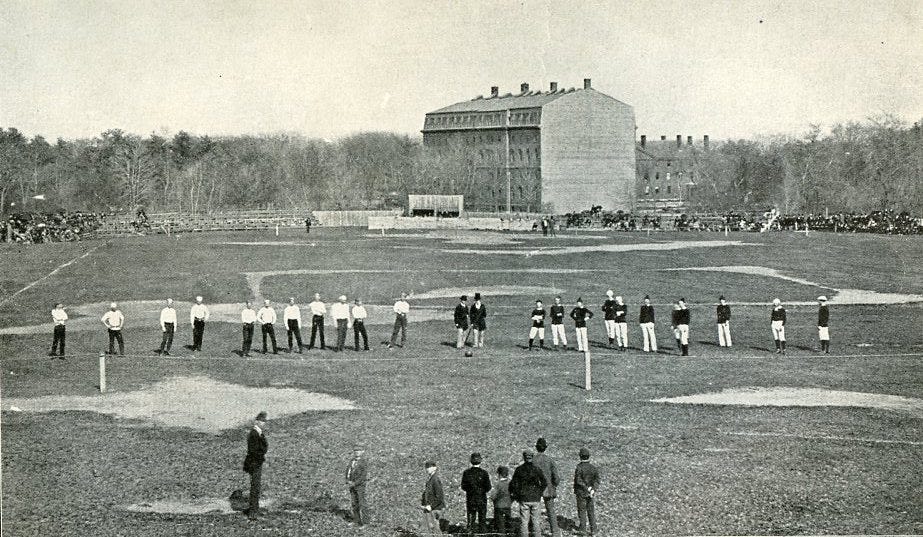Today's Tidbit... 1876 IFA Rule #61: # Players
This is #61 in a series covering football's original 61 rules adopted by the Intercollegiate Football Association in 1876. We reviewed one rule each Friday since last October.
This is the end, or nearly so.
We will consolidate some thoughts on the original 61 football rules next week, but today, we will focus on the final original rule of the game. Like Rule 60, which defined the field size, Rule 61 was newly created by the IFA. By tradition, rugby players knew the proper field size and did not specify one. They also did not need a rule to tell them there should be fifteen players per side, but the boys on the western side of the Atlantic formalized those traditions and turned them into rules:
Rule 61: The number of players shall be limited to fifteen upon a side.
Whereas scores of players participated in the traditional folk football games, the Princeton-Rutgers soccer matches of 1869 had 25 per side, and the 1874 Harvard-McGill games had 13 and 15 per side, depending on which team's rules they followed. The IFA adopted the rugby standard of playing 15 per side in 1876.
After the IFA established its rule, Camp and others at Yale promoted playing with 11 per side to provide more space per person and foster a more open game. Their idea became an IFA rule in 1880. Whether or not the Yalies foresaw the implications of shifting to 11 players per side, the result was that the ball more easily popped from the scrum and was picked up before being tossed to backs. Rather than continuing to play the scrum and maul-oriented rugby game native to England, reducing the number of players led to the backs avoiding the pile and sweeping the ends. Sweeps were more fun for the players and more entertaining for those watching from the sidelines.
Rugby later changed its rules and customs to shift to a sweeping, American-like game, so the open rugby style we know today originated in New England, not Old England. Subsequent changes to American tackling rules and allowing blocking sent American football back toward a rough-and-tumble game, but the sweep remained a part of football and reemerged several decades later.
America has used eleven players per side since 1880, while Canada’s team size floated around a bit. McGill adopted rules in 1874 that allowed anywhere from 10 to 20 players per side, and it was not until 1912 that 12 players per side became the standard in Canadian Rugby. That number stayed firm and remains today in Canadian Football.
Click the appropriate link for previous stories in the series:
Intro | #1 Drop Kick | #2 Place Kick | #3 Punt | #4 Goal Posts | #5 Goal | #6 Goal ≠ Punt | #7 Scoring | #8 Dead Ball | #9 Touchdown | #10 Tackle | #11 Scrimmage | #12 Ball Handling | #13 Dead Ball | #14 Scrimmage Ball Handling | #15 Run In | #16 Goal Line | #17 Boundary Lines | #18 Crying “Down” | #19 Maul In | #20 Maul in Pax | #21 Touch-in Goal | #22 Onside | #23 Offside | #24 Return to Onside | #25 Defensive Offside | #26 Throwing Back | #27 Knocking On | #28 Fair Catch | #29 Punt-out | #30 Punt-On | #31 Into Touch | #32 Inbounding | #33 Pushed Into Touch | #34 Right Angle Throw Out | #35 No Fair Catch | #36 Kickoff | #37 Kickoff Timing | #38 Change Goals | #39 Toss Up | #40 Loser Kicks | #41 Kickout | #42 Kickout Procedure | #43 Fair Catch Free Kick | #44 Free Kick Location | #45 Own Goal Touch Down | #46 Try At Goal | #47 Try At Goal Spot | #48 Touched Down Between Posts | #49 Puntout Spot | #50 Heel-In Mark | #51 No Fair Catch OOB | #52 TD Interference | #53 Missed Kicks | #54 Charging | #55 Charge At Once | #56 Charging Locations | #57 Hacking | #58 Gutta Percha | #59 Officials | #60 The Field
Football Archaeology is reader-supported. Click here to buy one of my books or otherwise support the site.


